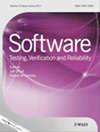Model‐based testing
IF 1.2
4区 计算机科学
Q3 COMPUTER SCIENCE, SOFTWARE ENGINEERING
引用次数: 0
Abstract
This issue contains two papers. Both papers focus on model-based testing. The first paper, “RATE: A Model-Based Testing Approach That Combines Model Refinement and Test Execution” by Andrea Bombarda, Silvia Bonfanti, Angelo Gargantini, Yu Lei, and Feng Duan, presents the RATE approach and its application to three case studies. The RATE approach helps testers verify the compliance of the actual implementation with respect to the specification of the system under test (SUT). In particular, the approach starts from an initial model of the SUT and refines the model based on the testing results of the previous refinement. The approach derives tests from Avalla scenarios written manually during validation or automatically generated from the model using the ATGT tool. The approach then executes the tests on the code implementation to obtain coverage information in order to identify missing system features or behaviours (not captured in the model) and add them to the next refinement. The authors have applied the approach to three different case studies and have shown the approach’s effectiveness. (Recommended by Manuel Nunez). The second paper, “Coloured Petri Nets for Abstract Test Generation in Software Engineering” by Alvaro Sobrinho, Ially Almeida, Leandro Dias da Silva, Lenardo Chaves e Silva, Adriano Araújo, Tassio Fernandes Costa, and Angelo Perkusich, presents an investigation of the current approaches of abstract test generation for Coloured Petri Nets (CPN) in order to guide testers to select a suitable approach when conducting model-based testing using CPN. In particular, the authors conduct a systematic literature review to investigate the current approaches of abstract test generation for CPN and then focus on specific implementations and advantages/disadvantages. The authors then conduct an empirical study with formal models of medical systems to study the current approaches of abstract test generation for CPN. The study results show that CPN provides reliable tests quickly, dependent on the applied approach of abstract test generation. (Recommended by Manuel Nunez).基于模型检测的测试
这一期有两篇论文。两篇论文都关注基于模型的测试。第一篇论文“RATE:一种结合了模型精化和测试执行的基于模型的测试方法”,作者是Andrea Bombarda、Silvia Bonfanti、Angelo Gargantini、Yu Lei和Feng Duan,介绍了RATE方法及其在三个案例研究中的应用。RATE方法帮助测试人员根据被测系统(SUT)的规范来验证实际实现的遵从性。特别是,该方法从SUT的初始模型开始,并根据先前细化的测试结果对模型进行细化。该方法从验证期间手动编写的Avalla场景或使用ATGT工具从模型自动生成的Avalla场景中派生测试。然后,该方法在代码实现上执行测试以获得覆盖信息,以便识别缺失的系统特性或行为(未在模型中捕获),并将它们添加到下一个细化中。作者将该方法应用于三个不同的案例研究,并证明了该方法的有效性。(曼努埃尔·努涅斯推荐)第二篇论文,“软件工程中抽象测试生成的彩色Petri网”,作者是Alvaro Sobrinho, ali Almeida, Leandro Dias da Silva, Lenardo Chaves e Silva, Adriano Araújo, Tassio Fernandes Costa和Angelo Perkusich,该论文对彩色Petri网(CPN)抽象测试生成的当前方法进行了调查,以指导测试人员在使用CPN进行基于模型的测试时选择合适的方法。特别地,作者进行了系统的文献综述,研究了当前CPN抽象测试生成的方法,然后重点讨论了具体的实现和优缺点。然后利用医疗系统的形式化模型进行实证研究,研究当前CPN抽象测试生成的方法。研究结果表明,基于抽象测试生成的应用方法,CPN能够快速提供可靠的测试。(曼努埃尔·努涅斯推荐)
本文章由计算机程序翻译,如有差异,请以英文原文为准。
求助全文
约1分钟内获得全文
求助全文
来源期刊

Software Testing Verification & Reliability
工程技术-计算机:软件工程
CiteScore
3.70
自引率
0.00%
发文量
34
审稿时长
>12 weeks
期刊介绍:
The journal is the premier outlet for research results on the subjects of testing, verification and reliability. Readers will find useful research on issues pertaining to building better software and evaluating it.
The journal is unique in its emphasis on theoretical foundations and applications to real-world software development. The balance of theory, empirical work, and practical applications provide readers with better techniques for testing, verifying and improving the reliability of software.
The journal targets researchers, practitioners, educators and students that have a vested interest in results generated by high-quality testing, verification and reliability modeling and evaluation of software. Topics of special interest include, but are not limited to:
-New criteria for software testing and verification
-Application of existing software testing and verification techniques to new types of software, including web applications, web services, embedded software, aspect-oriented software, and software architectures
-Model based testing
-Formal verification techniques such as model-checking
-Comparison of testing and verification techniques
-Measurement of and metrics for testing, verification and reliability
-Industrial experience with cutting edge techniques
-Descriptions and evaluations of commercial and open-source software testing tools
-Reliability modeling, measurement and application
-Testing and verification of software security
-Automated test data generation
-Process issues and methods
-Non-functional testing
 求助内容:
求助内容: 应助结果提醒方式:
应助结果提醒方式:


